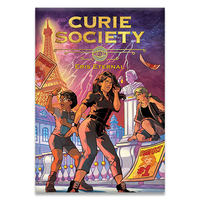'We're meeting people where they are': Graphic novels can help boost diversity in STEM, says MIT's Ritu Raman
"We're combating thousands of years of all of us having certain beliefs about who's capable of what, so I think we still have some work to do there"
Imagine a secret organization that combines the exceptional talents and physical skills of its agents with incredible gadgets to protect the world from evil villains bent on using science to rule the world.
No, we’re not talking about the next instalment of James Bond, but the incredible female scientists in the "Curie Society" series of YA graphic novels.
Following the exploits of teen science prodigies Simone, Maya and Taj, the two books in the series are action-packed adventures where the main protagonists learn how to use their gifts to become the next secret agents in The Curie Society — a secret organization formed to support exceptional female scientists around the world (and save it at the same time).
Ahead of the second book's launch, we spoke to MIT professor Ritu Raman, one of the lead science advisors on the series, about how graphic novels can help promote STEM education, why diversity is so important and what it's like to be immortalized in comic book form.
Alexander McNamara: How did you get involved in the making of the Curie Society books?
Ritu Raman: I met Heather and Adam [Einhorn and Staffaroni, authors of the books] several years ago when I was postdoc at MIT, and we were talking about how there's a lack of content for preteen and teenage girls that shows science in both an exciting way, but also an accurate way. Something that motivates people, but then also shows them, within reason, what's going on in the world of STEM today.
When Heather and Adam did the first book, they talked to a bunch of different scientists and engineers from a variety of different perspectives. There was a huge collaborative effort to put the first story together, which I think was particularly important when they're fleshing out the three main characters and their origin story.
Sign up for the Live Science daily newsletter now
Get the world’s most fascinating discoveries delivered straight to your inbox.
AM: What was your role in the series and how did you help in its creation?
RR: It changed between books. In the first, they talked to a lot of different scientists who do different kinds of work and had different paths to science. I think that was really important for them to take bits and pieces of people's authentic experiences and weave them into the characters.
Part of my story is moving around a lot growing up, and as a result I skipped a lot of grades bouncing between different schools. And so of the three characters, Simone's experience of being younger and not necessarily emotionally matched in maturity to the place that she is, while being matched scientifically, comes from me.
Then in the context of Maya, who is supposed to be South Asian or Indian, the cultural exploration of science and other things, I think come a little bit from myself. The third character [Taj], is polar opposite from me, but honestly, reminds me of one of my close friends.
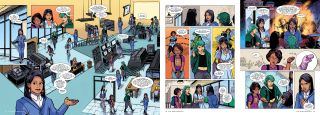
In the first book I shared my experience and provided feedback on a little bit of the science, but actually we talked more about depictions of bioethics and how scientists do or don't think about the consequences of their work. Who should be in the room when these decisions are being made? How do we portray a villain who starts off sort of as a good scientist and maybe things go wrong? I was providing feedback more at that level.
In the second book, they decided to pursue a strategy of having one main scientist to work with, and so I got to see the story and help craft it from very early visions. I did a lot more accuracy checking, but also if we needed a technology that would, say, paralyze somebody but not hurt them forever, I was brainstorming the different tools and technologies that could be highlighted.
We also decided to do a longer feature of the work that we do in our lab. Sometimes, when you want to make something super cool and exciting to read, you're depicting technologies five or 10 years from now, right? So we also wanted to give folks something that's happening in labs right now, and that people might be like, "Wow, I would have thought that that didn't exist yet."
We wanted to show myself, as well as the women working with me in my lab and the kinds of things that they do. It was really cool to be able to highlight some real students at MIT in the context of the Curie Society.
AM: How does it feel to be immortalized in comic book form?
RR: I'm living in the dream, really. I've always wanted to write and contribute to the world of fiction, but when I write for work, I'm a scientist, I write a very specific plan of how to get a grant funded in the next five years that will do exactly this and this. There's creativity in there, but it's creativity within very strict constraints, and I think the opportunity to release those constraints a little bit and still scratch that creative part of my brain, while talking about the science…. It's very cool, I'm very happy about it.
AM: That creative process is pretty important, and obviously the book is crammed with science. As the advisor to the story, how far can you push the science from fact to fiction?
RR: That's an interesting question, particularly because there are probably different aspects of science that I treat differently in that way. I mean one of the things about being a PhD trained scientist and working in a lab is that I know about some very niche areas, but then I also have a degree in mechanical and aerospace engineering. But it's not like I can really comment too deeply on some of the work on airfoil design for planes, which showed up in one of the books.
I sometimes feel like I'm hypercritical of the things that are closer to my work related to genetic engineering or making new tissues by 3D printing — that sort of stuff that I know a lot about. So the first thing I do is try to modulate. For things that are not directly in my area of expertise, I think I'm able to give a lot more freedom — if this passes the smell test or it doesn't defy or fundamentally break the laws of physics, it's good. Maybe it's not exactly perfectly right, but it's a story and that's OK. With stuff that is more related to the things that I do, I have to first try to censor myself a little bit more.
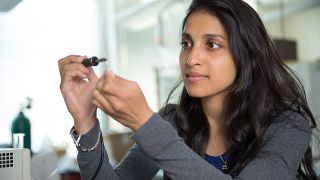
So I try to first turn off that part of my brain, but I think now that we've worked together for many years the team hopefully feels comfortable being like, "Hey, this is the reason we wanted to say it that way. If you feel this is fundamentally wrong, is there something else we could say that would still move the story from point A to point B?"
I think particularly being involved in an earlier draft is great, because then before they've committed too much to something, I can figure out how to best lead science into that. I think just having a good relationship with the authors over many years has helped.
AM: It must have been fun actually being able to explore other areas of science that you're not an expert in. Did you learn a lot from researching the story as well?
RR: Yeah, I mean, I'm not incentivized in my job to think outside of the exact context of what my lab works on because I'm paid to be an expert. Zooming back out and being a generalist sparks your own enthusiasm for the things that you thought were cool when you were a kid. I really wanted to go into aerospace and make rockets, and I still think those things are exciting, but it's not what I'm doing right now.
You can't do everything, but I think that some of the technologies, in particular related to energy and the climate crisis, are very exciting. Even though a lot of my work is focused on human health — which is great and very motivating — sometimes, as a human being living on the planet, you're also thinking more broadly about other grand challenges that are facing us. So catching up on what everyone else is doing is very heartening and exciting to see.
AM: How effective do you think graphic novels are in getting people into STEM.
RR: One of the things that I think is very important is make sure we're meeting people where they are. Some people respond really well to the written word, some people respond well to digital media, some people would prefer everything to be delivered to them in the form of a dance — and that's OK. Usually most people are a combination of those things and you need to hear stuff repeated three or four different times for it to really sink in.
I think graphic novels fit in a nice space. We have TV shows where people describe science for kids of different audiences, and there's a lot of YouTube videos that do that. Science fiction novels also do a job of exploring that space, but they often seem to target older audiences and really focus on dystopian visions of the future.
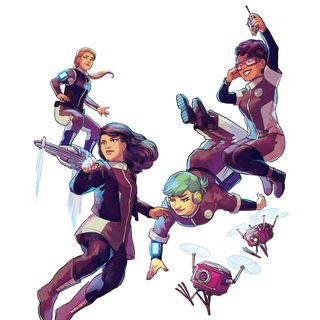
So when you're thinking about this audience, how do you introduce realistic science fiction in a visually compelling way, that has a narrative and also highlights several different kinds of people? You could certainly do it through superhero movies, but [graphic novels] are another way of doing it that I think could actually reach a ton of people, and can be something they revisit over time. Maybe it's in their bookshelf and they look at it but can't understand it the first time; then they go and they learn something in school and they can come back and go to that page.
I think it's one part of the arsenal, which doesn't have a ton of things in it right now, but there's a big opportunity for us to reach a lot of people who would not otherwise see these kinds of stories.
AM: The book itself has a very diverse cast of characters and is obviously focused on getting more women into STEM. From your perspective, is science doing enough to make this positive change, and what more could we be doing?
RR: I think as long as society is evolving we're always playing catch up in any discipline to make sure that we're capturing whatever the current distribution of the population is. I think in science, for example, we have made tremendous progress in recruiting more women into undergraduate programs — certainly at MIT we've had 50% women in our undergraduate programs for many years, which is lovely — but as you go farther along, certainly in graduate school, in the professoriate, in the leadership of STEM businesses, the representation, at least of women and certainly people that match different aspects of diversity, it's still very low.
One of the things I really like about the way the Curie Society structures its characters is that even though the protagonists are younger, there are a lot of older female scientists that are portrayed as really senior people in the books. I think that's very important because they pretty openly acknowledge that the world they faced was fairly different to what these younger girls are facing, and that interplay has been really nice to see. I haven't really seen that in other media or other stories.
I do think that despite inroads in getting more people excited about science, when I interact with middle schoolers, and teenage girls in particular, there is still a lot of hesitation and a lack of self-belief about the role that they can play in science. I don't think it's something that we can pat ourselves on the back and say, "This is a solved problem, we don't need to worry about this anymore." We're combating thousands of years of all of us having certain beliefs about who's capable of what, so I think we still have some work to do there, at least to keep the pipeline going.
But we also have to recognize that just getting a bunch of 12-year-olds excited about science is not enough. You need to actually preserve and promote and retain that enthusiasm throughout their lives, and that's a much longer scale problem.
AM: Do you think there are any particular challenges to getting younger people, particularly young girls, into science? Is there anything we can do?
RR: One threat that I see right now is that it's wonderful to highlight women and young girls that are excited about science, but if those are the only people in the story, you're sort of removing them from a natural context or the fact that we live in a very gender-diverse society. I would love to see more male characters interacting with these female scientists in respectful ways.
I think we need to be very careful of not just telling young women to pursue science, but also educating young men that, "Did you know that there are women who do science and are very good at it and we can all play together and do cool things?"
More broadly, making sure our interventions are not just targeted at people who identify as girls is the missing gap in the field that we can keep pushing toward.
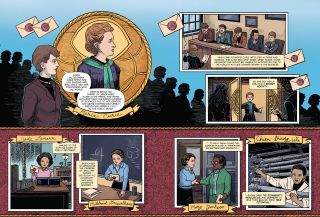
AM: So essentially what we need to do is see more people who are in the science environment in front of people talking about what we're doing?
RR: Yeah, and get more young boys to read these books too. I just think about the number of books I read as a kid that featured young boys and I still learned a lot from them. I would love for it to go the other way. Yes the story is about women and I hope young girls like it, but I hope a lot of boys read it too and think that it's an exciting story and something to emulate.
AM: Finally, if you were a character in the book, what would your specialized skill be? If you're already a member of the Curie Society and are keeping it secret, that's fine…
RR: One of the things I always wish I could do — particularly because we in my lab are always building little tissues and models of the human body and then trying to understand what happens inside the human body — is being able to go inside a person and see exactly what's going wrong. I think probably being able to see, at very high resolution, how cells are talking to each other and how we can manipulate that, that would probably be the secret skill — but you'll never know, I'll never tell.
The Curie Society ($18.95) and The Curie Society, Volume 2: Eris Eternal ($22.95) are available on Amazon
Although aimed for teenagers, the Curie Society books are an excellent read for anybody who is after a science-tinged caper. It's great to see how the characters develop, tackling topics like cultural expectations and sexuality which are sympathetically woven into the story alongside scientific ideas like gene editing and robots.

Most Popular


